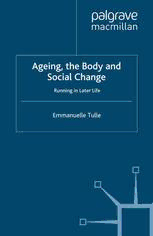
Ageing, the Body and Social Change: Running in Later Life PDF
Preview Ageing, the Body and Social Change: Running in Later Life
Ageing, the Body and Social Change AlsobyEmmanuelleTulle OLDAGEANDAGENCY THEBODY,CULTUREANDSOCIETY:AnIntroduction(co-editedwithHancock,P., Hughes,B.,Jagger,E.,Paterson,K.,Russell,R.,andTyler,M.) Ageing, the Body and Social Change Running in Later Life Emmanuelle Tulle GlasgowCaledonianUniversity,UK ©EmmanuelleTulle2008 Softcover reprint of the hardcover 1st edition 2008 978-0-230-51759-2 Allrightsreserved.Noreproduction,copyortransmissionofthis publicationmaybemadewithoutwrittenpermission. Noparagraphofthispublicationmaybereproduced,copiedortransmitted savewithwrittenpermissionorinaccordancewiththeprovisionsofthe Copyright,DesignsandPatentsAct1988,orunderthetermsofanylicence permittinglimitedcopyingissuedbytheCopyrightLicensingAgency, 90TottenhamCourtRoad,LondonW1T4LP. Anypersonwhodoesanyunauthorizedactinrelationtothispublication maybeliabletocriminalprosecutionandcivilclaimsfordamages. Theauthorhasassertedhisrighttobeidentified astheauthorofthisworkinaccordancewiththeCopyright, DesignsandPatentsAct1988. Firstpublished2008by PALGRAVEMACMILLAN Houndmills,Basingstoke,HampshireRG216XSand 175FifthAvenue,NewYork,N.Y.10010 Companiesandrepresentativesthroughouttheworld PALGRAVEMACMILLANistheglobalacademicimprintofthePalgrave MacmillandivisionofSt.Martin’sPress,LLCandofPalgraveMacmillanLtd. Macmillan(cid:2)isaregisteredtrademarkintheUnitedStates,UnitedKingdom andothercountries.PalgraveisaregisteredtrademarkintheEuropean Unionandothercountries. ISBN 978-1-349-35519-8 ISBN 978-0-230-22763-7 (eBook) DOI 10.1057/9780230227637 Thisbookisprintedonpapersuitableforrecyclingandmadefromfully managedandsustainedforestsources.Logging,pulpingandmanufacturing processesareexpectedtoconformtotheenvironmentalregulationsofthe countryoforigin. AcataloguerecordforthisbookisavailablefromtheBritishLibrary. AcatalogrecordforthisbookisavailablefromtheLibraryofCongress. 10 9 8 7 6 5 4 3 2 1 17 16 15 14 13 12 11 10 09 08 Contents ListofAbbreviations vi Introduction vii 1 EmbodyingAgeing 1 2 DebatesintheSociologyoftheBody 18 3 SocialFieldsasSpacesofDisruption 40 4 CapturingAgeingEmbodiment 61 5 DisruptedBiographies 77 6 TheEmbodimentofAthleticMastery 94 7 ManagingAgeing 114 8 MappinganEmbodiedSociologyofAgeing 140 Conclusion 161 Notes 167 References 168 Index 178 v List of Abbreviations HR Hillrunner LD Long-distancerunner:specialisingindistancesexceeding 10km LD/r Retiredlong-distancerunner T&F TrackandFieldathlete:mainlysprintersandtriplejumpers T&F/r RetiredTrackandFieldathlete UR Ultrarunner:specialisingindistancesexceedingmarathon distance(26miles) vi Introduction “We’ve got to run here’’, Marc said, tapping a brown puddle sonata with a Nike-clad toe. “You must fight the postmodern experience! You’ll have the time of your life’’. His youthful enthusiasmbeliedhis54years. (Ottati2002:19) Canwereallychangetheworldbyrunning?Orputanotherway,canthe wayweuseourbodiesreflectoreveninitiatesignificantsocialchange? Howdoweknowthatanychangesobservedarereallysignificant? Inthisquotethenarratorandhisrunningpartnerhavereachedages at which most people have stopped aspiring to physical competence of the kind inherent in the pursuit of athletic excellence. These older runnersandthosewhowillgivefleshtothesociologicalanalysistobe presented in this book are deadly serious. Over several years, and even decades, they have shaped their lives, their psychological tendencies, theiraspirationsand,aboveall,theirbodies,bysubjectingthemselvesto demandingtrainingregimesandracingschedules.Atthesametimethey holddowndemandingjobsandareactivespouses,parentsandfriends. WhenMarcisencouraginghisrunningmatestochoosethemuddyrun- ning trail over the drier and more dependable course, he is not only urgingthemtoembraceafullphysicalexperienceoveramoresanitised one, but also testing their discipline. Running is a challenge to post- modern (read, inauthentic, virtual) living and a test of one’s physical competence. Is it also a significant challenge to ageing? There is a clue totheprobleminthelastsentenceofthequote. In this last sentence the narrator draws attention to his friend’s age and contrasts it with his “youthful’’ attitude. This is a typical trope in accountsofage,whichservestochallengepreconceptions.Juxtaposinga relativelyelevatedagewithaclaimtoyouthfulnessimpliesthatageneed notbeatimeofnarrowhorizonsandnegativeattitude.Atthesametime it also implies that old age is not desirable. Does this trope challenge stereotypes of old age and old people? Is having youthful enthusiasm exemplifiedbythewilltochallengethebodythewaytotransformthe vii viii Introduction arguablydiminishedstatusofolderpeople?Thesequestionsareusefulto kick-starttheanalysisthatwillbedevelopedinthebookandthecentral questionswhichwillhelpgenerateit. Iproposethattoaddressthesequestions,thesociologyofageingand old age needs to be embodied. I will undertake this by focusing on a veryspecificgroupofolderpeople–VeteraneliterunnerssuchasMark above – and explore how this process of embodiment can be achieved by investigating their lived experiences, with a primary focus on the everyday management of the body as it has evolved over time. More specifically,Iwishtothrowlightontheinterrelationshipbetweenbod- ilyprocesses(bywhichImeannotonlythesensationsofthebodybut alsotheengagementwithidiosyncraticphysicalandphysiologicalstruc- tures),sociallocationandidentity,withinthecontextofageing,thatis withinacontextofchange.InthiswayIhopetoopenthewayforthe- oreticaldevelopmentandrefinementinsociologicalunderstandingsof ageingandoldagetochallengetheerosioninsocialandculturalcapital whichthreatensusasweenteroldage. The concerns which animate this book continue a project of critical enquiryinageingstudieswhichhasbeenongoingforsometime.Inthe last 20 years the building blocks of a critical sociology of ageing have beenlaid.Keytexts,steepedinFoucauldianthought,haveunpackedin minutedetailthemodalitiesofthesocialconstructionofageingandold agesincetheadventofmodernity(Green1993;Katz1996).Thesecon- tributionshaveaffirmedthatageingandoldageneednolongersimply be slaves to biological processes. The fact that they were was shown to betheresultofthedevelopmentofbiomedicine,withthelatterprovid- ingtheprimarydiscursiveframeworkwithinwhicholdageandageing cametobeknownandexperienced.Theseanalysesconfirmedtherole oftheageing,medicalisedbodyinattitudestowardsolderpeople.Other publicationshavesignalledthearrivalofpostmodernityinstudiesofage- ing.Theculturalcontextinwhichageingandbeingoldisexperienced hasbeenscrutinised(Blaikie1999;Featherstoneetal.1991;Featherstone and Wernick 1995; Gilleard and Higgs 2000; Hepworth 2000). Much of what people fear about ageing and old age has been shown to be associated with the cultural marginalisation and concomitant loss of identity which arise from the stereotypes of old age. These stereotypes wereseenasunderpinnedbybodilyageingorratherbybeliefsaboutbod- ilyageing,withthelatterlargelyandunquestioninglyperceivedwithin abiomedicalframework. Thusthebodyoccupiesacentralplaceintheproblematisationofold age.However,italsoplaysanambiguousroleinthestrategiesdescribed Introduction ix in the literature which ageing social actors have at their disposal to manage their physicality. As we will see in Chapter 1, there is a tend- ency to respond to bodily ageing by rejecting its salience. And yet, according to Turner (2003), impending frailty is an inherent feature of our ontological position. If this is the case, then ageing embodiment cannot be sidelined and we need to attend sociologically to its social, culturalandpersonalimplications.Indeedhowcanonerespondmean- ingfullytotheontologicalunsettlingthatwouldcomefromincreasing frailty? The question is not aimed purely at individuals but must be set in a widersocialandculturalcontext.Rejectingthebodytoprotectontolo- gicalintegrityandmaintainculturalrelevanceisfraughtwithdangers.It confirmsthattheageingbodyhasnovalue,thatitisdevoidofanykind ofcapital.Andyet,assomeoftheliteratureisbeginningtouncover,age- ingsocialactorsdomanagetheirbodiesandtheydosowithinspecific structures–suchasdiscourses,institutions,economicconditions–which variouslyopenuporrestricttherangeofbodyworkavailabletothem. Insomesettings,suchasbeautysalonsorinthegym,peopleengagein whatonemightcallactivebodyworkinanattempttorestorevalueto what they perceive is diminishing capital. In other settings, such as in nursinghomes,peopleengageinmorepassive–albeitnolesspowerful– bodyworktocopewiththedepersonalisationandlossofindependence arisingoutoftheroutinesofthesesettings.Thereforethebodyisalways present and it is always used in some way by ageing social actors and thosearoundthem. This leads to another question: does the management of the ageing body lead to meaningful change in the ontological position of older people (at an individual level) and in their social status? As we shall see, there is much danger in the strategies currently at the disposal of ageing social actors to manage bodily ageing. The danger is that these strategies,farfromrehabilitatingageing,wouldinfactreinforcetheneg- ative position of older people; that is to say, they would leave the age order undisturbed. Currently there is little in the literature which can helpusfindawaytowardstherehabilitationofageingexperiencesand provide a challenge to the diminished social location of people who are becoming or have become old. Therefore I propose to turn to two other areas of sociology which I think can supply much fruitful theor- etical and conceptual tools to develop what I will hopefully convince the reader is an innovative framework to make sense of contempor- ary ageing experiences and to work out ways of challenging the age order.
